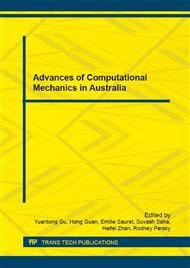[1]
G. Schumacher, Coal Pulverising Mill Types. Information on (https: /books. google. com. au/books?isbn=0646537598).
Google Scholar
[2]
Australian Standard, AS 2074 – 2003 Cast Steel, Austenitic Manganese Steel Casting Grades AS2074/H1A, SAI Global Publishers.
Google Scholar
[3]
Y.F. Wang, and Z. G. Yang, Finite element model of erosive wear on ductile and brittle materials. Wear, 265, (2008) 871-878.
DOI: 10.1016/j.wear.2008.01.014
Google Scholar
[4]
M.S. Eltobgy, E. NGandM.A. Elbestawi, Finite element modeling of erosive wear. International Journal of Machine Tools and Manufacture, 45, (2005) 1337-1346.
DOI: 10.1016/j.ijmachtools.2005.01.007
Google Scholar
[5]
M. Takaffoli, and M. Papini, Numerical simulation of solid particle impacts on Al6061-T6 Part II: Materials removal mechanisms for impact of multiple angular particles. Wear, 296, (2012c) 648-655.
DOI: 10.1016/j.wear.2012.07.022
Google Scholar
[6]
Q. Chen and D. Li, Computer simulation of solid particle erosion. Wear, 254, (2003) 203-210.
DOI: 10.1016/s0043-1648(03)00006-1
Google Scholar
[7]
M. Takaffoli, and M. Papini, Material deformation and removal due to single particle impacts on ductile materials using smoothed particle hydrodynamics. Wear, 274–275, (2012a) 50-59.
DOI: 10.1016/j.wear.2011.08.012
Google Scholar
[8]
X. Wang and J. SHI, Validation of Johnson-Cook plasticity and damage model using impact experiment. International Journal of Impact Engineering, 60, (2013) 67-75.
DOI: 10.1016/j.ijimpeng.2013.04.010
Google Scholar
[9]
A.A. Cenna, A.A. Page, N.W. Kisi, and M.G. Jones, Single particle impact tests using gas gun and analysis of high strain-rate impact events in ductile materials. Wear, 271, (2011) 1497-1503.
DOI: 10.1016/j.wear.2010.11.023
Google Scholar
[10]
K. Shimizu, T. Noguchi, H. Seitoh, M. Okada, and Y. Matsubara, FEM analysis of erosive wear. Wear, 250, (2001) 779-784.
DOI: 10.1016/s0043-1648(01)00716-5
Google Scholar
[11]
Y.F. Wang, and Z.G. Yang, A coupled finite element and meshfree analysis of erosive wear. Tribology International, 42, (2009) 373-377.
DOI: 10.1016/j.triboint.2008.07.009
Google Scholar
[12]
H. Kurtaran, M. Buyuk, and A. Eskandarian, Ballistic impact simulation of GT model vehicle door using finite element method. Theoretical and Applied Fracture Mechanics, 40, (2003) 113-121.
DOI: 10.1016/s0167-8442(03)00039-9
Google Scholar
[13]
S. Hassani, J. Klemberg-Sapieha, M. Bielawski, W. Beres, L. Martinu, and M. Balazinski, Design of hard coating architecture for the optimization of erosion resistance. Wear, 265, (2008) 879-887.
DOI: 10.1016/j.wear.2008.01.021
Google Scholar
[14]
M. Junkar, B. Jurisevic, M. Fajdiga, andM. Grah, Finite element analysis of single-particle impact in abrasive water jet machining. International Journal of Impact Engineering, 32, (2006) 1095-1112.
DOI: 10.1016/j.ijimpeng.2004.09.006
Google Scholar
[15]
E. Yarrapareddy, andR. Kovacevic, Numerical simulation and characterization of slurry erosion of laser cladded surfaces by using failure analysis approach. Journal of Failure Analysis and Prevention, 7, (2007) 464-474.
DOI: 10.1007/s11668-007-9083-8
Google Scholar
[16]
M. Bielawski, and W. Beres, FE modelling of surface stresses in erosion-resistant coatings under single particle impact. Wear, 262, (2007) 167-175.
DOI: 10.1016/j.wear.2006.04.009
Google Scholar
[17]
G.R. Johnson, and W.H. Cook, Fracture characteristics of three metals subjected to various strains, strain rates, temperatures and pressures. Engineering fracture mechanics, 21, (1985) 31-48.
DOI: 10.1016/0013-7944(85)90052-9
Google Scholar
[18]
D. Macdougall, and J. Harding, A constitutive relation and failure criterion for Ti6Al4V alloy at impact rates of strain. Journal of the Mechanics and Physics of Solids, 47, (1999) 1157-1185.
DOI: 10.1016/s0022-5096(98)00086-6
Google Scholar
[19]
H.W. Meyer Jr, and D.S. Kleponis, Modeling the high strain rate behavior of titanium undergoing ballistic impact and penetration. International Journal of Impact Engineering, 26, (2001) 509-521.
DOI: 10.1016/s0734-743x(01)00107-5
Google Scholar
[20]
G.R. Johnson, and W.H. Cook, A constitutive model and data for metals subjected to large strains, high strain rates and high temperatures. Proceedings of the 7th International Symposium on Ballistics, The Netherlands, (1983) 541-547.
Google Scholar
[21]
Information on: Abaqus Analysis User's Manual, Vol 3, (2012).
Google Scholar


